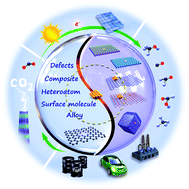Surface strategies for catalytic CO2 reduction: from two-dimensional materials to nanoclusters to single atoms†
Abstract
Redox catalysis, including photocatalysis and (photo)electrocatalysis, may alleviate global warming and energy crises by removing excess CO2 from the atmosphere and converting it to value-added resources. Nano-to-atomic two-dimensional (2D) materials, clusters and single atoms are superior catalysts because of their engineerable ultrathin/small dimensions and large surface areas and have attracted worldwide research interest. Given the current gap between research and applications in CO2 reduction, our review systematically and constructively discusses nano-to-atomic surface strategies for catalysts reported to date. This work is expected to drive and benefit future research to rationally design surface strategies with multi-parameter synergistic impacts on the selectivity, activity and stability of next-generation CO2 reduction catalysts, thus opening new avenues for sustainable solutions to climate change, energy and environmental issues, and the potential industrial economy.

- This article is part of the themed collection: 2020 EES Lectureship Winner: Wooyul Kim


 Please wait while we load your content...
Please wait while we load your content...